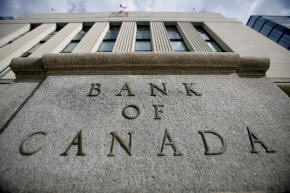Investors bet on Bank of Canada setting G7 pace in move to neutral rates
 Send a link to a friend
Send a link to a friend
 [May 13, 2022] By
Fergal Smith [May 13, 2022] By
Fergal Smith
TORONTO (Reuters) - As Canada's economy
overheats, the Bank of Canada is likely to be among the first of the
major central banks to lift interest rates to a more normal setting even
as worries persist about record-high levels of household debt,
strategists say.
Money markets expect Canada's central bank to continue to raise rates by
half a percentage point at its next two policy meetings, in June and
July, after it hiked by that increment last month, its biggest single
increase in 22 years.
That would lift rates to the bottom of the 2% to 3% range that the
central bank estimates to be a neutral setting, or the level at which
monetary policy is no longer stimulating the economy.
The economy likely expanded at an annualized rate of 5.6% in the first
quarter. That's well ahead of the BoC's projections and compares with a
contraction in the United States and barely any growth in the euro area.

"The BoC has the strongest case for already being at neutral of any peer
group central bank out there," said Derek Holt, head of capital markets
economics at Scotiabank.
Ending monetary stimulus could reduce the risk of inflation becoming
embedded in the economy. The move is likely more urgent with economic
activity exceeding capacity.
Among G7 central bank's, the Federal Reserve and the Bank of England
could also lift rates to neutral in the coming months. The Fed's
estimate of neutral is in line with Canada's central bank but the BoE's
is much lower at 1.25% to 2.25%.
Unlike the Fed, Canada's central bank does not have a dual mandate
targeting employment as well as inflation, nor has it adopted average
inflation targeting.
"There may be that perception, especially with international investors,
that the BoC is perhaps a bit more proactive and less tolerant of high
inflation," said Jimmy Jean, chief economist at Desjardins Group.
[to top of second column] |

A sign is pictured outside the Bank of Canada building in Ottawa,
Ontario, Canada, May 23, 2017. REUTERS/Chris Wattie/

Canada's inflation rate hit a 31-year high of 6.7% in March, while jobs have
climbed well above pre-pandemic levels and the economy continues to benefit from
a surge in commodity prices that has been amplified by the war in Ukraine.
Government spending continues to add economic stimulus in Canada, while
population growth is raising demand for housing and other services, strategists
at TD Economics, including Beata Caranci, said in a note.
"This means that the Bank of Canada may face a larger challenge than the Federal
Reserve in snuffing out the inflation impulse," the strategists said.
Canada's economy is likely to be particularly sensitive to higher rates after
Canadians borrowed heavily during the pandemic to participate in a red-hot
housing market. Still, the BoC says the economy is strong enough to handle
further tightening.
All the major central banks are "dealing with private debt and housing
affordability issues but if anyone can pull off neutral – and beyond - then it's
got to be the BoC," Scotiabank's Holt said.
(Reporting by Fergal Smith; Editing by Nick Zieminski)
[© 2022 Thomson Reuters. All rights
reserved.]
This material may not be published,
broadcast, rewritten or redistributed.
Thompson Reuters is solely responsible for this content.
 |